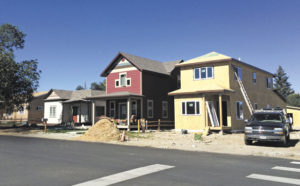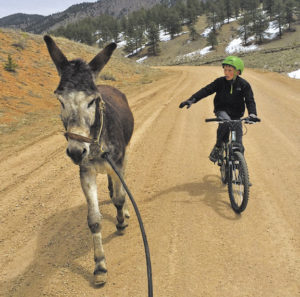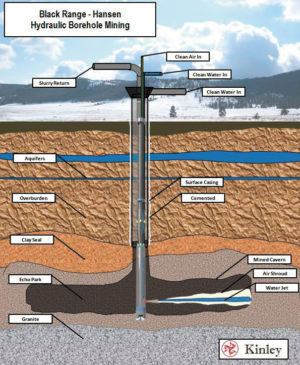The absence of affordable housing in a tourist town means a large segment of the seasonal work force must relocate, or make compromises and sacrifices. Long commutes from less expensive areas increase pollution while reducing the net income of workers due to transportation costs and lost time.Central Colorado is a popular and growing recreation region. Recreationists want good roads, fire protection and law enforcement, scenic campsites and trails, great music, theater, lattes, yoga, fast-service restaurants, access to lively retail and periodic displays of great activity on holidays. Some want to build vacation homes that strut their balance sheet while putting an uneven demand on local services. After creating seasonal demand, the recreationists leave their pollution and trash, and ignore the surplus capacity in their wake. A seasonal labor force must work long hours during the active season and figure out how to survive in the off season.
This pattern has been true for a long a time. Recreation is good for business, sales tax revenues, and upgraded amenities. It is understood that the tourism industry is here to stay. Adapt or perish. Most businesses that have survived in recreation regions have adapted, with one exception: affordable housing for the worker bees. The same qualities that make a region attractive for recreation also make it attractive for people with surplus capital to retire or relocate for the quality of life. While this provides a more permanent population with a steady demand that creates more season-long employment options, the flow of surplus capital drives up the cost of even a meager abode.
It seems like a cat’s cradle that won’t unwind.
I must take a left turn here and mention a point made in one of my prior columns that humans are the only species on Earth that engages in high-octane recreation, and the only species that travels great distances for reasons of curiosity and enjoyment rather than for food, safety, or reproduction. Other species understand that conservation of energy is the key to fitness, longevity and the need to live off an annual solar dividend. Travel takes energy. No species other than homo sapiens shows such total disregard for the costs and traffic damage of recreation. Perhaps even worse, some recreationists build large trophy homes that clutter the wild, place an erratic demand on services and basically say to the worker bees living in a single-wide: “Eat cake.”
With all that in mind: a few thoughts on the topic of housing in a tourist region.
1. Prior to World War II, the majority of U.S. citizens rented rather owned a place to live. Home ownership simply was not on the bucket list of the American Dream. I recall my father getting a lot of pushback from his parents when he decided to build a house in Fort Collins after he returned from the war. “You’ll be stuck with a mortgage,” they warned.
In some ways, my grandparents were right. Housing is not an investment, it is the cost of shelter, just as a car is the cost of transportation. There are exceptions, of course. A home bought in a low market and sold in a high market may appear to be an investment, but then the seller must purchase replacement housing in the high market, or relocate to a less expensive market. Relocating has a cost, both in cash and in lack of continuity and community.
In a column written in 2008, I presented data to support the suggestion that owning a home since WWII has not been as financially rational as investing that same capital in an interest-bearing alternative and using the earnings to pay rent. With all the emphasis these days on the monthly payment rather than the total price, people often forget that a mortgage payment is mostly interest, and ownership has other costs: taxes, insurance, repairs and maintenance, expensive surprises ranging from squirrels in the attic to floods and transaction costs in buying and selling. When all of the costs of home ownership are given ledger status in the calculation, owning a home is not, over the long term, as financially rational as renting.
But Americans cherish the security and pride of owning a home and they have been willing to pay for it in spite of the financial irrationality. Rent is seen as “money down the drain” while interest payments and ownership costs have curiously, and often incorrectly, taken on the color of equity. The cause of this distortion was the great tax break of the 1980s that allowed the interest on a home mortgage to be deducted from one’s adjusted gross income, which, in turn, encouraged the use of a home as an ATM. We now know how that turned out. In a way not often highlighted, the push to encourage home ownership by both the private and public sector over the last sixty years has led to an increase in the price of homes, and thus increases in rent, as the owners of investment rentals need a positive cash flow to pay ownership costs.
[InContentAdTwo] Prior to WWII, homes, multiplexes, and large apartment complexes were owned by wealthy people who had more patient capital – that is, they expected a return of two or three percent rather than ten or fifteen – and tenants often lived in the building their entire lives. My grandparents lived in the same apartment for over fifty years and rent increases were seldom and small. They had a familial relationship with the landlord.
By stimulating home ownership rather than renting, we have actually destabilized the housing market by cross-threading the basic necessity of shelter with the notion of housing as an investment. We don’t consider food an investment nor do we expect clothing to appreciate or serve as collateral for a loan. But we are cresting an eerie boom period with housing in which we want to have our home and speculate with it too. Housing as an investment is perhaps more prevalent in recreation regions, which only widens the affordable housing gap for the work force. An increase in interest rates and elimination of the mortgage interest deduction are probably inevitable at some point, and these changes might, after a painful adjustment, restore the housing market to the basic reality of shelter.
2. Tourism and vacationing are peculiar to homo sapiens, made affordable by the use of stored solar energy (gas), technology (cars, trains and planes), and a regulatory structure that allows tourists to dump their trash into the air, land and water at a discount, and in the case of vehicle emissions, the pollution is dumped for free. Environmental Economics attempts to give ledger status to the “hidden” tail of costs associated with pollution and traffic damage, referred to as externalized costs, and ways these costs might actually be paid by those responsible. It’s not easy. U.S. citizens are in a free country where cheap energy, free trash dumping, and extensive recreation are considered basic human rights.
Various taxes on tourism tend to suppress consumption, and the introduction of bureaucratic processes to administer and collect externalized costs often invites a host of subjective assessments and arguments about infringing on our liberty. Nevertheless, take a look: public lands are being steadily degraded, trash collection has become a full-time job, and federal and state agencies are imposing more and more fees and limits on the use of public lands, straddling the interests of the environment and the dependence of recreation areas on the collateral income stream. But the bias is to protect the environment. The sheer force of human traffic on tourist regions will bring a future with more fees and restrictions as people exit the cities for recreation only to find that the city has followed them. Looking at this trend through a focused lens, it is possible that the public lands will eventually be barred from all human traffic because the human traffic is destroying the public lands. We already see a growing emphasis on virtual visitations rather than paving a way for the enormous human footprints.
3. Some business owners have come up with strategies to keep jobs active year-round in tourist regions by vertical or horizontal integration, or changing structures during slow times. In the ag business, labor is expected to show up in the spring and work through harvest, then go on unemployment during the winter. I did not like this on-off seasonal supply cycle because it meant uncertainty about the return of reliable people. The way I dealt with it was to shut down the operation from roughly Thanksgiving through Valentines Day, but divide the salary into twelve parts and continue to pay during the two months’ break. The time off during holidays was welcome, and the holidays are a good time to charge one’s batteries and be with family.
This alternative doesn’t work for all businesses, but some combination of extended business activity and a long paid vacation can result in higher wages and a more stable work force that can afford to settle in the community. Another solution is for the municipality to raise sales taxes or issue bonds in this low interest market to fund construction of lower cost housing. Towns can also make building codes less strenuous. With full respect and appreciation for public safety, there are a lot of regulations that exist because of lobbying by various interest groups seeking job security from the fees generated by the administration of compliance.
4. I think we all understand that this is an issue with few easy answers. Our freedom-and-growth ethic in this country is sending us down the road to oligarchy. The evidence is in the distribution and concentration of capital: home prices and rents correlate strongly with the cost of capital rather than the needs of people. When interest rates are low, more people can qualify for a mortgage to own a home; this tends to drive up the price of homes because more people are bidding for the same properties; accordingly, this leads to higher rents and eventually excludes all but the one percent.
Right now, low interest rates mean the cost of capital is attractive, but is nevertheless restricted to many of us in the 99 percent for a couple of reasons. First, our central bank makes capital available to banks at less than one percent, so banks weigh the risk of making a home loan with the usual associated risks versus the sure thing of buying government bonds that yield two or three percent. This remarkably easy arbitrage, together with banking regulations that have had a disproportionate impact on regional banks, has tended to make capital more available to those who already have ample capital and probably don’t need to borrow.
Second, low interest rates stimulate purchasing appetites, which can result in debt being used to purchase depreciating assets, such as cars and appliances, and generally encouraging a risk-on disposition among borrowers. This not only reduces the capital of those most in need as they buy necessities on time; it also tends to make banks conservative as they see the typical anatomy of bad loans.
Taking this lumpy burst of thoughts and influences into account, it does feel as though humans have painted themselves into a series of corners in which we must hope for a benign oligarchy, a political class of adults, continued restraint in the use of nuclear weapons, and technological advances that reduce our pillaging of Earth. The good news is that in Central Colorado, our problems would be considered success stories in much of the world.
John Mattingly cultivates prose, among other things, and was most recently seen near Poncha Springs.




